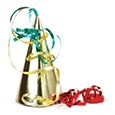Jump into the new year with fresh, well-defined goals, innovative organizational and practice techniques, and a renewed passion for playing.
Take Care of the Instrument
Start the new year off right with a set of new strings. Save the old set of strings in a separate envelope and label the envelope with the current date. This makes it easy to remember when new strings were put on the instrument. If the old strings are frayed or unraveled, throw them away instead.
Always keep an extra set of new strings and an extra set of old strings. Old strings are useful replacements if a string breaks minutes before a lesson or performance. It is safe to use a small amount of rubbing alcohol on the fingerboard to clean it while changing strings. Do not use rubbing alcohol with plain gut strings or on a fingerboard that has inlays. Make sure rubbing alcohol does not come into contact with any other part of the instrument.
New strings are even more enjoyable with fresh bow hair. Start a new cake of rosin at the same time as the rehair so the new hair is not in contact with any grime from the old cake of rosin. Make it a goal to keep the bow hair at the frog clean and rosined.
Take the instrument to the luthier and have them check for open seams, a hazard of the winter months. The luthier may adjust the placement of the bridge and sound post and recommend a fingerboard planning or other repair. Ask the luthier to remove excess rosin buildup so that your instrument looks as beautiful as if sounds.
Restock Accessories
Replace the batteries on metronomes and tuners, and store spare batteries in a logical place. Some players use metronome and tuning apps, so make sure apps are easily accessible on the preferred device. Many violinists and violists use shoulder rests or sponges, and the new year is a perfect time to purchase a spare. Cellists should check rockstops and straps, and basses can reevaluate their seating options. Make sure pencils are sharpened, erasers are functional, sticky notes are still sticky, and the lesson or practice notebook has spare pages.
Organize Music
Many players carry music bags stuffed with every piece of music they have studied, performed, or printed out in the last five years. A well-organized music bag includes a folder or binder with current music, a lesson or practice notebook, relevant scale and etude books, ensemble music, pencils, and metronomes. A personalized or monogrammed music bag is less likely to be stolen or confused with someone else’s at a group rehearsal. Store extra music in a plastic file box that has a handle and can be easily moved and lifted. Cardboard boxes are not a preferred method for storing music because they are subject to water damage.
Create a Music Calendar
Create a separate calendar that contains important musical information like lesson and ensemble rehearsal times, audition dates, summer camp application deadlines, and competition details. The most functional and useful calendars include lists of required repertoire for each musical activity and deadlines for learning pieces or mastering techniques. Consider using a different colored pen for each musical category: green pen for performances, blue pen for rehearsals, purple pen for paperwork or applications, and red pen for personal goals.
Practice with Brains and Balance
Work with a teacher or coach to design a well-balanced practice routine. Productive practice sessions include technical studies like scales, arpeggios, and etudes; a piece that has been learned and is in the final polishing stages; and a new piece that demands analytical practice. Pair difficult repertoire with easy repertoire to avoid mindless practice or frustration. Practice slowly and in different types of rhythms, bowings, and patterns. Experiment with taking a five-minute break every thirty minutes or a ten-minute break each hour to see which leads to the most concentrated work.
Some players think the cozy atmosphere of a small practice room is conducive to focused practice, while others find small places limiting and claustrophobic. Experiment with different sized rooms, including large performance spaces, to find the right fit for productive practice.
Make a list of priorities for each practice session. It is easier to accomplish concrete goals when actual goals are in place. For instrumentalists who struggle to stay motivated while practicing, try setting a timer for ten or fifteen minutes. Divide an hour-long practice into these ten or fifteen minute increments instead of trying to spend a complete hour practicing.
Commit to a Healthy Playing Position
Most students have received ample advice about proper playing position from private teachers, ensemble directors, and adjudicators. Now is the time to clean up weak technique; get violin and viola scrolls up, solidify standing and seating positions, keep the left-hand fingers close to the fingerboard, and commit to a beautiful, balanced bow grip. Reevaluate hand position. Is every finger where it should be? Are thumbs relaxed and bent? Are pinkies sticking up or curling inward?
Study videos and photographs of accomplished players and compare them to your personal playing position. Sometimes practicing in the mirror or filming a personal recording can accomplish as much as a private lesson. Remember that practicing with bad habits reinforces those habits, making it harder to change technique later.
Improve Tone
Practice open strings every day. Play full-bow whole notes with an even, sustained tone. Be able to play in every part of the bow in every dynamic. Divide the bow into thirds and use sticky notes to understand and improve bow distribution. Set the metronome to 60 and create different bowing patterns. Try seven beats on a down bow followed by one beat on an up bow to gain control of slow bow speeds at the frog. Then try to sustain a beautiful mezzo forte tone for 15-20 seconds.
Players often neglect off-the-string practice because it involves the lower half of the bow and takes well-developed right-hand flexibility. Practice a long brush stroke near the wrapping at the frog. If the stroke is uneven, practice the stroke with the bow on the string or with the upper arm and elbow resting against a wall. Then practice a rapid spiccato stroke (sautillé) in the middle of the bow. In the sautillé stoke, the hair of the bow actually stays on the string but the stick is flexible, which creates the illusion of a bouncing bow. To develop greater flexibility in the right hand, practice string crossings in the middle of the bow, letting the right hand guide the action instead of the arm.
Improve Rhythm
Sit down with scores and practice counting aloud. Know where all the beats in the measure are and be able to subdivide note values both mentally and physically (bowed subdivisions). Drill time signatures and review the differences between simple and compound meter. Find a book of rhythmic exercises and accurately sightread two or three a day. Practice with the metronome – and with bowed subdivisions and the metronome at the same time. Count out loud and stick to one system for counting subdivisions. For example, some people use the syllables one-e-and-a to subdivide the first beat of a measure into sixteenth notes.
Improve Intonation
Tune the instrument carefully before starting to play. Use a tuner or a tuning app to check pitch or to set up a drone while practicing scales and arpeggios. Create double stops while crossing strings to listen for resonance. Check all first fingers with the open string above, articulating perfect fourths. Check the pitches G, D, A, and E with the corresponding open strings.
Analyze each position change to make sure there is a shifting plan. Shifts on an old bow should be led by the old finger, and shifts on the new bow are led by the new finger. Often old-bow, old-finger shifts can be measured with a guide note that is created by dragging the old finger to the new position.
To make good intonation permanent, practice placing the finger on the string, committing to its placement, and then adding the bow. The finger is either in the right place or not. If finger is in the wrong place or wiggling around, go back and start over. Practicing with spiccato bow strokes also improves intonation. The finger is either in place at the beginning of the spiccato stroke or it is still finding its way into position.
Listen
Players sometimes forget to listen while practicing. Although this seems like an obvious task, make a commitment to listening more carefully. In ensemble practice, listen to what is happening on the next stand and across the room. In a chamber music setting, be able to follow along with everyone’s part. The best chamber musicians are people who are not only easy to play with but also listen the deepest. For musicians who find it difficult to play and listen at the same time, work with an audio recorder to listen to passages immediately after playing them. Listening extends outside of the practice room. Listen to recordings, explore lesser known works, and attend concerts.
Enjoy
Practicing an instrument and working on musicianship is a process, and improvement can seem imperceptible at times. When frustrated, some players enjoy bringing out easy pieces that they have known for a long time. Playing an easy piece at a high level creates confidence and brings joy. Other players find that listening to music they love brings back the excitement of practice and makes them remember why they want to play. Other performers benefit from a day off from practice to reboot and start with a clear enthusiasm the next day. Seek out new playing opportunities, new collaborators, and enjoy the learning.






